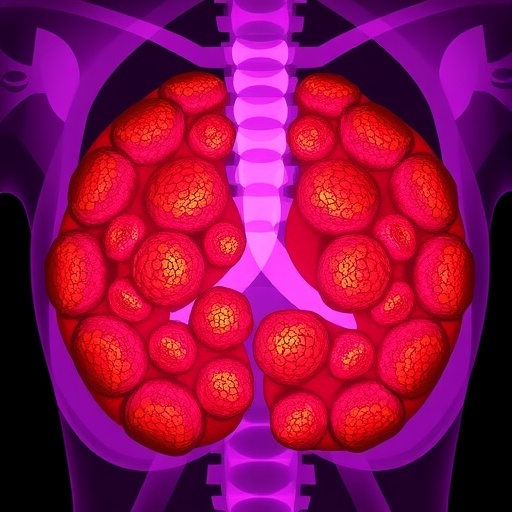In a groundbreaking study published recently in Nature Communications, an international team of researchers has unveiled critical new insights as they establish reference values for cardiac dimensions and functions within a rural population living in a region endemic for loiasis in the Republic of the Congo. This research fills a significant gap in cardiovascular epidemiology, addressing the paucity of data regarding cardiac health in populations exposed to tropical parasitic infections, which are known to induce chronic systemic inflammation and potentially influence cardiac morphology and performance.
Loiasis, caused by the parasitic worm Loa loa, is a filarial infection endemic to several regions in Central Africa, including the Congo basin. Despite its known clinical manifestations, such as Calabar swellings and transient conjunctival migration of adult worms, its systemic effects on cardiac health remain poorly understood. The current study employed rigorous echocardiographic methodologies to meticulously chart normative cardiac parameters in a population that has, until now, been grossly understudied in cardiovascular research contexts.
The investigators utilized state-of-the-art echocardiographic imaging techniques, capitalizing on high-resolution ultrasound equipment to capture detailed views of cardiac chambers, wall thickness, valvular function, and overall myocardial contractility. Such imaging is paramount because echocardiography uniquely provides non-invasive, real-time visualization of cardiac architecture and dynamic function, indispensable for establishing baseline physiological parameters in this unique demographic.
Importantly, the researchers selected a representative cohort comprising individuals residing in rural villages within the loiasis-endemic zones of the Republic of the Congo. The population sampling was meticulously stratified by age and sex, ensuring that subsequent reference ranges for cardiac dimensions and function reflected natural variability without bias introduced by urban lifestyle or confounding cardiovascular risk factors prevalent in industrialized settings.
One of the main findings revealed intriguing deviations in cardiac chamber sizes and contractile indices when compared against Western-centric reference values that currently dominate clinical echocardiography practice worldwide. For instance, the study highlighted variations in left ventricular end-diastolic dimensions and interventricular septal thickness that are subtly distinct yet statistically significant, emphasizing the need for population-specific cardiac measurement standards.
This divergence may partly stem from genetic, nutritional, environmental, and infectious disease exposures unique to the rural Congolese context, including chronic exposure to parasitic infections like loiasis. Chronic parasitemia and the immunological perturbations it induces could conceivably modulate myocardial remodeling processes, influencing cardiac morphology in a manner heretofore undocumented.
Furthermore, the researchers delved into myocardial functional metrics, such as ejection fraction and diastolic function parameters. These indices provide critical insight into the heart’s pumping efficiency and compliance under physiological stresses. Establishing normative data for these parameters in loiasis-endemic populations constitutes a vital step toward accurate clinical assessment and early detection of subclinical cardiac dysfunction.
The implications of these findings extend well beyond academic curiosity. By creating tailored reference ranges for cardiac size and function, clinicians working in endemic areas can improve diagnostic precision, distinguishing between pathological alterations and ethnically or environmentally normative variations. This precision reduces diagnostic uncertainty, preventing misclassification that could lead to unnecessary treatments or missed therapeutic opportunities.
Importantly, these findings also pave the way for epidemiological surveillance of cardiovascular morbidity in loiasis-endemic regions, facilitating early interventions and potentially guiding public health policies. Understanding the baseline cardiac phenotype helps unravel how endemic infections like loiasis intersect with chronic diseases such as hypertension and heart failure, which are rising in prevalence in many low-resource settings.
This study further highlights the vital role of echocardiography as a scalable and relatively affordable imaging modality in resource-limited areas. When coupled with robust epidemiological data, echocardiography can bridge the healthcare gap by enabling frontline providers to monitor cardiac health effectively and tailor medical care to the population-specific profile.
The methodology employed, combining field-friendly data acquisition with sophisticated offline image analysis, demonstrates the feasibility of conducting high-quality cardiovascular research in remote settings. Such advances are critical for inclusive global health research that respects the biological diversity of human populations rather than extrapolating from narrow datasets.
In essence, this research underscores the need to regionalize and contextualize cardiovascular diagnostic norms, moving beyond the one-size-fits-all paradigm that has dominated global cardiology. The team’s holistic approach integrating parasitology, cardiology, and epidemiology symbolizes a new frontier in understanding heart health through a truly global lens.
These echocardiographic reference values thus assume dual significance: improving cardiac care in endemic areas and serving as catalysts for further inquiry into how infectious diseases modulate cardiovascular structure and function. As the study authors suggest, this lays foundational groundwork for longitudinal studies exploring causal mechanisms and clinical outcomes associated with cardiovascular changes in parasitized populations.
In closing, this research constitutes a vital leap toward equitable cardiovascular health by providing the necessary tools and data to interpret cardiac imaging in populations historically marginalized in medical research. It emphasizes the interdependence of infectious and non-communicable diseases in shaping human physiology and urges the global medical community to broaden its investigative horizons accordingly.
The authors’ work not only fills a critical data void but also opens exciting avenues for multidisciplinary inquiry, combining advances in parasitology, cardiovascular imaging, and epidemiology to enhance health outcomes in tropical regions. By challenging existing standards and advocating for context-specific norms, this study promotes a new vision for cardiovascular research—one that is as diverse and dynamic as the populations it aims to serve.
As we stride into an era of personalized medicine, this research exemplifies how embracing the complexity of environmental and infectious factors can revolutionize our understanding and treatment of cardiac diseases worldwide. The Republic of the Congo, through this landmark study, emerges as a beacon illustrating the power of local data to transform global health paradigms.
Subject of Research: Cardiac dimensions and function in a rural population living in a loiasis-endemic area of the Republic of the Congo, using echocardiography.
Article Title: Reference values for cardiac dimensions and function in a rural population living in a loiasis-endemic area of the Republic of the Congo: An echocardiographic study.
Article References:
Wafeu, G.S., Dupasquier, V., Campillo, J.T. et al. Reference values for cardiac dimensions and function in a rural population living in a loiasis-endemic area of the Republic of the Congo: An echocardiographic study. Nat Commun 16, 9109 (2025). https://doi.org/10.1038/s41467-025-64131-5
Image Credits: AI Generated
Tags: cardiac morphology and performancecardiac reference valuescardiovascular epidemiologychronic systemic inflammation effectsCongo basin health studiesechocardiographic methodologiesfilarial infections and heart diseasehigh-resolution ultrasound in cardiologyloiasis endemic populationnormative cardiac parametersparasitic infections and cardiac healthrural population health research





